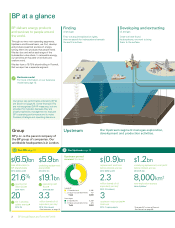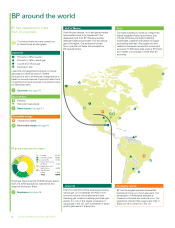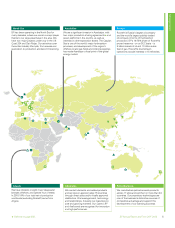BP 2015 Annual Report Download - page 15
Download and view the complete annual report
Please find page 15 of the 2015 BP annual report below. You can navigate through the pages in the report by either clicking on the pages listed below, or by using the keyword search tool below to find specific information within the annual report.
BP Technology Outlook
Technology choices for a secure, affordable
and sustainable energy future
November 2015
Energy efficiency
Greater efficiency helps with affordability –
because less energy is needed; with security –
because it reduces dependence on imports; and
with sustainability – because it reduces
emissions. Innovation can play a key role in
improving technology, bringing down cost and
increasing efficiency. In transport, for example,
we believe energy-efficient technologies and
biofuels could offer the most cost-effective
pathway to a secure, lower-carbon future.
All sorts of energy required
We believe a diverse mix of fuels and
technologies is needed to meet growing energy
demand, while supporting the transition to a
lower-carbon economy. These are reasons why
our portfolio includes oil, gas and renewables.
Oil and natural gas
Over the next few decades, we think oil and
natural gas are likely to continue to play a
significant part in meeting demand for energy.
They currently account for around 56% of total
energy consumption, and we believe they will
decrease to about 54% in 2035. For comparison,
under the International Energy Agency’s most
ambitious climate policy scenario (the 450
scenarioa), oil and gas would still make up 50%
of the energy mix in 2030 and 44% in 2040 –
assuming carbon capture and storage is widely
deployed.
Oil is a good source of energy for transportation
as it has a high energy density. That means
vehicles go further on less weight and volume
of fuel than alternatives. Also, oil’s liquid form
makes it easy to move around, globally and
locally. For these reasons, we expect oil to still
account for almost 90% of transportation fuels
in 2035 – compared with 94% today.
Natural gas is likely to play an increasing role in
meeting global energy demand, because it’s
available at scale, relatively low cost and lower
carbon than other fossil fuels. By 2035 gas is
expected to provide 26% of global energy,
placing it on a par with oil and coal.
BP Energy Outlook provides our projections of
future energy trends and factors that could affect
them out to 2035, based on our views of likely
economic and population growth and
developments in policy and technology. Also
available in Excel and video format.
The BP Technology Outlook shows how
technology can play a major role in meeting the
energy challenge by widening energy resource
choices, transforming the power sector,
improving transport efficiency and helping to
address climate concerns out to 2050.
See bp.com/technologyoutlook
See bp.com/energyoutlook
We believe shale gas will contribute more than
half of the growth in natural gas globally
between 2014 and 2035. In the US, the growth
of shale gas has already had a significant impact
on gas demand as well as CO2 emissions, which
have fallen back to 1990s levels.
The increasing gas supply in the US and other
countries is encouraging the use of liquefied
natural gas worldwide, which is expected to
double between 2014 and 2035.
New sources of hydrocarbons may be more
difficult to reach, extract and process. BP and
others in our industry are working to improve
techniques for maximizing recovery from
existing and currently inaccessible or
undeveloped fields.
Renewables
Renewables are the fastest-growing energy
source. Over the past few years, there has been
rapid expansion of the use of solar power due to
cost reduction in manufacturing and public
subsidies. That said, renewables, excluding
large-scale hydroelectricity, currently account for
around 3% of energy consumption. While they
are starting from a low base, we estimate that
by 2035 they will contribute around 9% of total
global energy demand.
Temporary policy support is needed to help
commercialize lower-carbon options and
technologies, but they will ultimately need to
become commercially self-sustaining, supported
only by a carbon price.
Beyond 2035
We expect that growing population and per
capita incomes will continue to drive growing
demand for energy. These dynamics will be
shaped by future technology developments,
changes in tastes, and future policy choices –
all of which are inherently uncertain. Concerns
about energy security, affordability and
environmental impacts are all likely to be
important considerations. These factors may
accelerate the trend towards more diverse
sources of energy supply, a lower average
carbon footprint, increased efficiency and
demand management.
Oil
Gas
Coal
Renewables
Hydro
Nuclear
2035
2015
1995
0 3 6 9 12 15 18
Energy consumption
(billion tonnes of oil equivalent)
Today around 32% of energy consumed
comes from oil, 30% from coal, and 24%
from gas – so 86% from fossil fuels in total.
Hydroelectricity accounts for 7%, nuclear for
4% and other renewables for just 3%.
Source: BP Energy Outlook.
Our strategy
Find out how BP can help meet energy
demand for years to come on page 12.
Climate change
Our sector has an important part to play
in addressing climate change. See page
46 to find out what BP is doing.
a From World Energy Outlook 2015. © OECD/International
Energy Agency 2015, page 35. The IEA 450 scenario assumes
a set of policies that bring about a trajectory of greenhouse gas
emissions from the energy sector that is consistent with
limiting long-term average global temperature increase to 2°C.
BP Annual Report and Form 20-F 2015 11
Strategic report
11
Strategic report
























